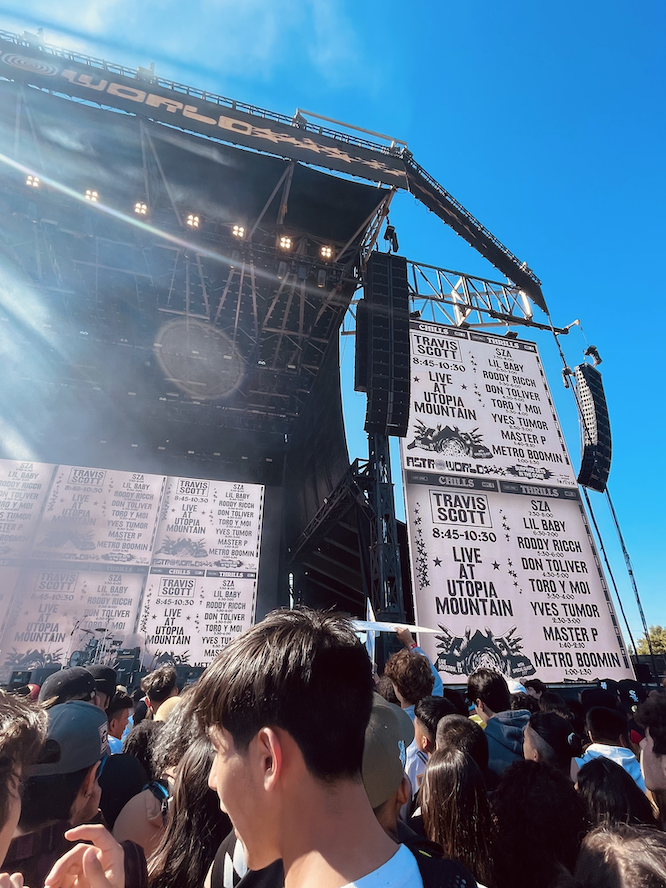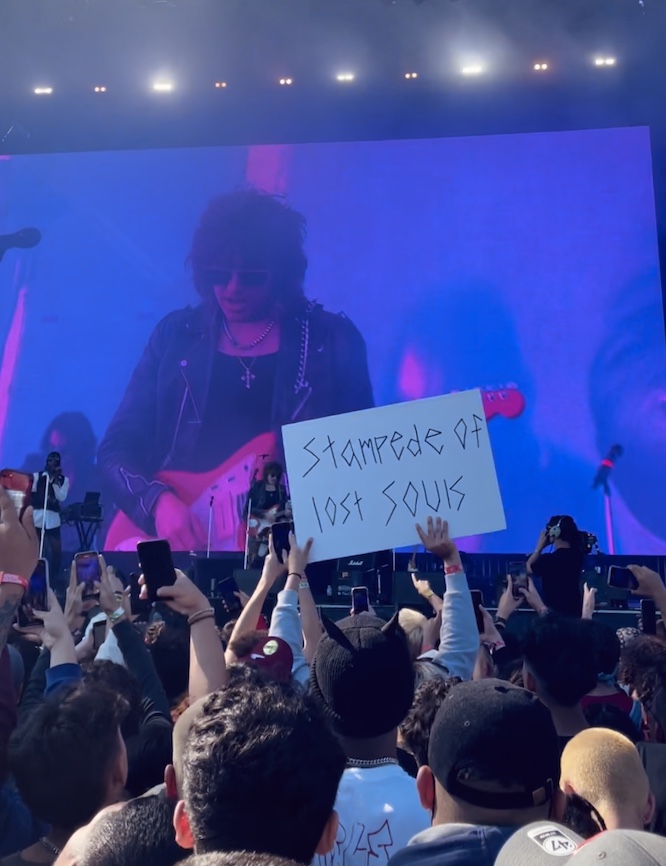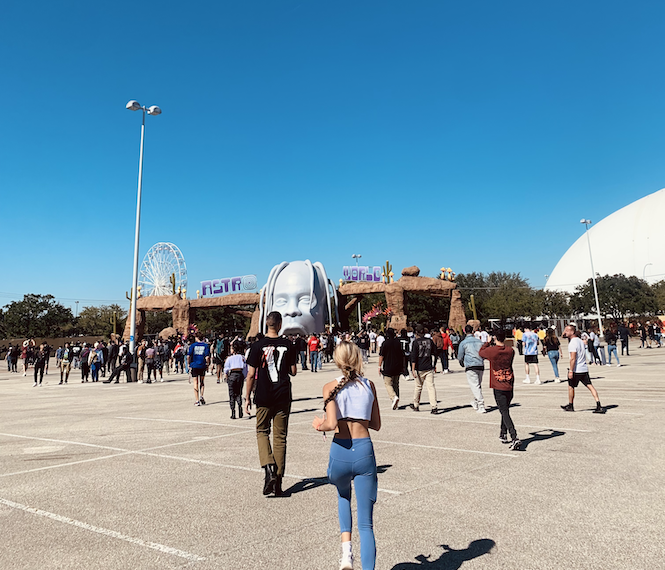Angelica Ruzanova runs towards the Astroworld Festival entrance marked by a giant inflatable object depicted as Travis Scott’s head, a landmark that has made an appearance throughout all his previous festivals. Photo by Camille Nul
By Angelica Ruzanova
Edited by Pete Ramirez
There is nothing quite like the anticipation and thrill you experience before attending a concert. Months worth of built-up energy, relentless preparation, and memorizing music culminate in a grand euphoric experience shared with other fans.
But when the audience’s temporary bliss of a live performance becomes an out-of-control mob, you have no choice but to give in to the uncontrollable forces of the crowd.
Multiple investigations are trying to figure out how harmless enjoyment turned the third-annual Astroworld Festival into a catastrophic event, leaving 10 attendees dead and hundreds more injured. The festival, founded and headlined by superstar rapper and Houston native, Travis Scott, has sparked a living hell for the survivors and the families of the lost concert-goers.
After my friends and I attended the 2019 Astroworld Festival, we expected a similar experience extended into two days rather than one. The festival felt like its own Travis Scott mini-world, with everything from a Cactus Jack pop-up store to amusement park rides.

Photo by Angelica Ruzanova
It soon became painfully obvious to us that the number of concert-goers had more than doubled, and the Astroworld “utopia” seemed beyond the maximum capacity offered at the venue. As we noticed the lines of fans growing larger and the crowd becoming extremely packed, things did not feel quite right.
I witnessed people who were missing shoes and wristbands required for entry after running through unprotected security fences. I also observed inattentive staff skipping the mandated COVID-19 tests once the lines of attendees grew longer and more impatient.
With only one single water dispenser area in the arena, people grew dehydrated and ill. Those who fainted as a result of these circumstances were crowd-surfed out of moshing pits. A vast landscape of haze covered the area near the stage as groups of people smoked in the midst of the crowd.
The countdown before Travis Scott’s grand-finale performance felt like the calm before a storm. As minutes turned into seconds, the spaces in between each person morphed us all into a collective clump of bodies.
My friends and I were standing near the front of the crowd on the stage-right side and we were quickly swept up in the shifting waves of people around us, who unintentionally stomped on our feet and continuously hit us with their shoulders. At one point in the madness, I was able to lift up my feet and be held up in the air due to the intense pressure of those surrounding me.
As the crowd’s mixture of excitement and impatience grew more ravenous, people began forcing their way toward a better view of the famous rapper. This came at a cost to those who were in a more vulnerable, unprotected area where they struggled for relief and gasped for fresh air.
I was fortunate enough to grasp onto someone’s backpack which allowed me to make my way through the crowd, but many others were stuck towards the center with no chance to get out.

Photo by Angelica Ruzanova
To be honest, most attendees did not realize what was happening at the time, but when the tragic news came out, it was a mind-boggling thought.
“I remember at first it took a while for the news to settle for me, to comprehend how big of a deal it all actually was,” said Isabella Conti, a fellow Austin Community College student who attended the festival with her friends.
“I thought to myself, this could’ve been my friends. It could’ve been anyone”, Conti said. “And the ages of those young kids reminded me of my younger brother. They were kids who went to the concert expecting to have fun and enjoy music.”
The night at NRG Park on the 5th of November ended with 10 confirmed deaths, hundreds of injured attendees and a crowd of over 50,000 people. The Houston Police Department is currently investigating exactly how this tragedy unfolded.
Rumors have run rampant after the event. Stories have spread throughout social media of involuntarily injected security guards, drugs laced with fentanyl sold to some of the attendees and even a conspiracy theory of a satanic ritual.
One of the deadliest concerts in United States history has resulted in more than 100 lawsuits being filed against festival organizers and performers, including Live Nation and Travis Scott himself.
“After trying to stay optimistic about the situation, I got angrier with what I heard. The more I learned about the circumstances, the more aware I grew,” Conti said. “I hope this horrible tragedy will change safety measures which go ignored by many festival organizers, and the ‘rager’ mentality gets the awareness it deserves. The tragedy trickles down to poor organization and people’s lack of decency when it comes to helping those around them.”
Our generation chases ceaseless sprees of carpe diem within the pressures of our social media presence. Carpe diem, a Latin phrase for making the most of the present time with little thought for the future, holds a dangerous explanation to why some concert-goers danced on ambulances that carried unconscious fans rather than at least standing back.
The cost of this failure by numerous parties is personal and painful. We must remember and honor these 10 young people who died:
- Brianna Rodriguez – 16 years old
- Axel Acosta Avila – 21 years old
- Madison Dubiski – 23 years old
- Danish Baig – 27 years old
- Rudy Peña – 23 years old
- Jacob Jurinek – 20 years old
- Franco Patino – 21 years old
- John Hilgert – 14 years old
- Bharti Shahani – 22 years old
- Ezra Blount – 9 years old


